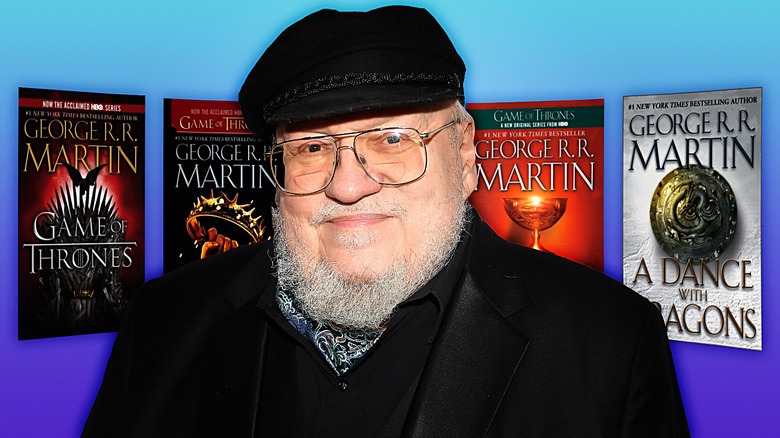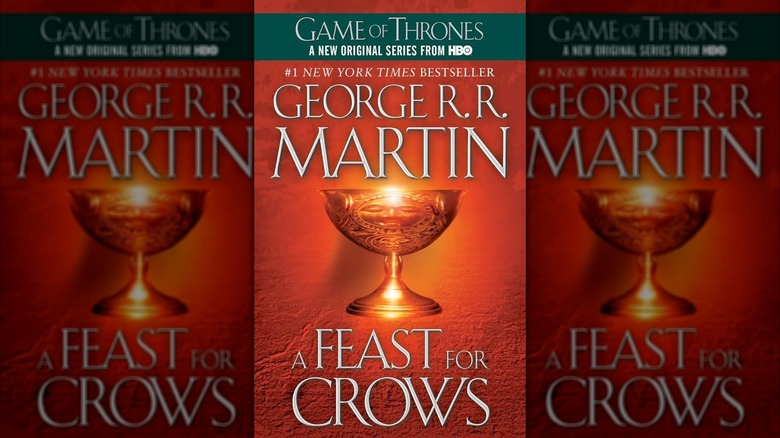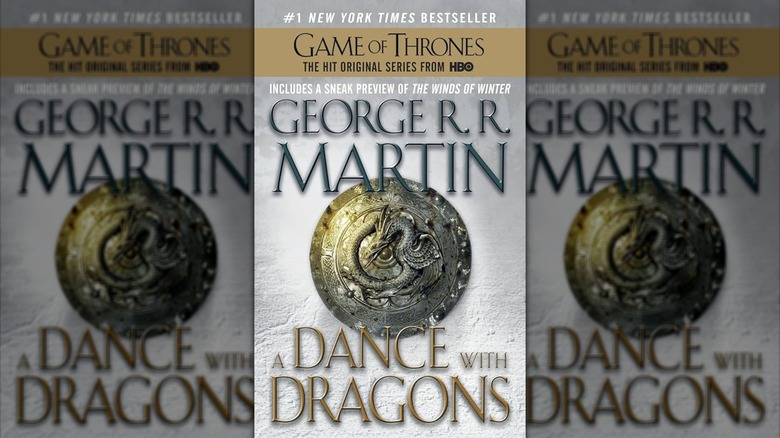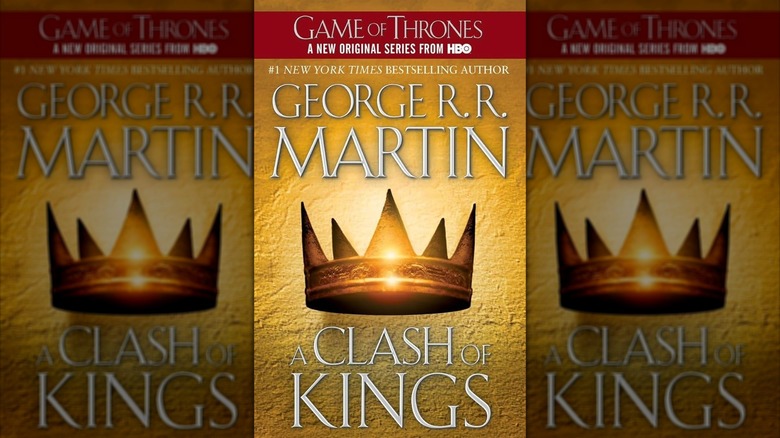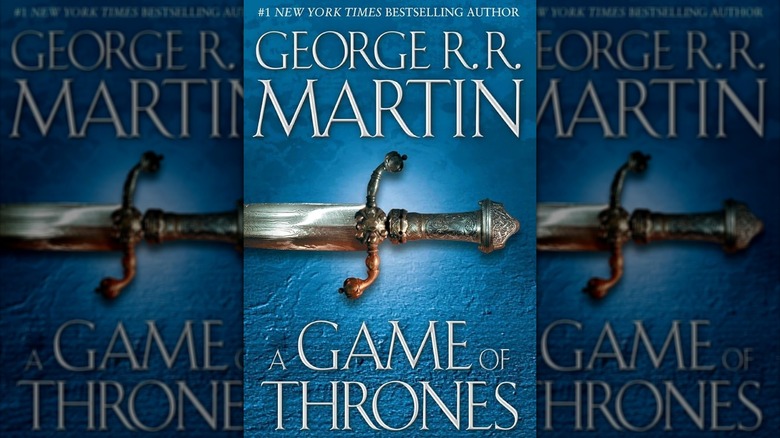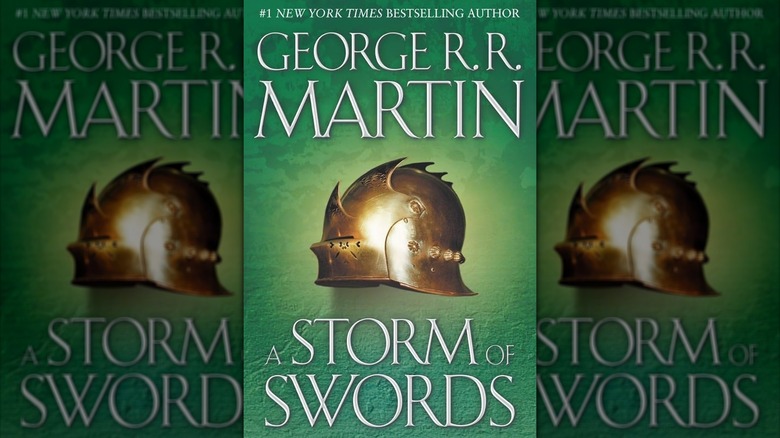Every Game Of Thrones Book, Ranked
Considering that "Game of Thrones" — the hit HBO fantasy series that created a new generation of stars and became one of the premium network's biggest shows until its ignominious ending — was so recent, you'd be forgiven if you forgot the source material dates back by a few decades. In 1996, series author George R.R. Martin penned the first installment of his fantasy series "A Song of Ice and Fire," itself titled "A Game of Thrones," and started a new literary phenomenon. These days, with one TV hit in the rearview and another, the prequel "House of the Dragon," currently underway, "Game of Thrones" is one of the biggest pop culture franchises around, managing to bring fantasy into the mainstream in a huge way. So what about the books that inspired it all?
A few housekeeping matters before we get going: any side projects like "Fire & Blood," the basis for "House of the Dragon," won't be included here, and no — it doesn't seem like the sixth book, "The Winds of Winter," will materialize soon (if at all), to say nothing of "A Dream of Spring." Whether you're already familiar with Martin's original five installments of "A Song of Ice and Fire" or the HBO adaptations have inspired you to get started, here's Looper's ranking of the books from worst to best. (What qualifies me to rank these? I've read them all and covered the shows extensively ... and I have opinions.)
5. A Feast for Crows (Book 4)
The biggest problem with "A Feast for Crows" — as well as the second-worst entry on this list — is that, when push comes to shove, it's half a book. As George R.R. Martin himself disclosed in 2005 when it was on the brink of being published, "A Feast for Crows" and the following book, "A Dance of Dragons," were basically one enormous book split into two parts, meaning that each one only really contains half of a lengthy story. To make matters worse, because all the books of "A Song of Ice and Fire" are divided by chapters featuring a different chaacter's point of view, "A Feast for Crows" only tells the stories of a selection of Martin's vast array of vascinating characters.
No shade to Arya Stark and Cersei Lannister, who are definitely fascinating, but this isn't exactly a striking point in either of their overall journeys — Cersei is mostly dealing with financial muckery and legal matters, while Arya is going to face-changing school in Braavos and ends the book blinded by the Faceless Men. The rest of the book focuses on Brienne of Tarth, Sansa Stark, Jaime Lannister, Samwell Tarly, and a handful of relatively dull characters in Dorne and the Iron Islands. The book doesn't feature Tyrion Lannister, Daenerys Targaryen, or Jon Snow — arguably the three "main" characters of the entire narrative. It's a slog.
"A Feast for Crows" was ultimately adapted into the fifth season of "Game of Thrones" along with its counterpart ... and it's safe to say it was much more compelling onscreen than it is in print.
4. A Dance with Dragons (Book 5)
There's no element of surprise here, except for the fact that "A Dance with Dragons" is slightly better than "A Feast for Crows" at the end of the day. Part of this is due simply to the fact that it features way more characters, all of whom are doing something at least sort of interesting. (Some, like Arya, Cersei, and Jaime, end up returning.) Up in the North, the book focuses on Jon Snow, Bran Stark, and Davos Seaworth, and it also devotes a fair amount of time to a broken-down Theon Greyjoy — who, as he's being tortured by the horrific villain Ramsay Bolton, is in his "Reek" era (so to speak).
Elsewhere in Essos, we reunite with Tyrion Lannister ... although, to be honest, his storyline isn't great in this book, as he spends quite a bit of time sailing in the hopes of meeting Daenerys, instead meeting an off-brand potential usurper Aegon Targaryen and then quickly getting kidnapped by Jorah Mormont, who will then bring him to Daenerys. (He also spends a long while riding a pig as part of a degrading show, and it's easy to imagine that Peter Dinklage worked to avoid that bit making it into the adaptation, which simply has Tyrion meeting Daenerys without the in-between strife.) Daenerys has, by this book, managed to conquer Mereen, but now has to deal with the Sons of the Harpy; her story ends much like the Season 5 finale, where she's captured by stray Dothraki. Again, "A Dance of Dragons" isn't as bad as its other half, but it still doesn't feel complete ... for obvious reasons.
3. A Clash of Kings (Book 2)
"A Clash of Kings" may not be the best book in "A Song of Ice and Fire," but at least it doesn't split up the characters and tell one long trudge of a story between two books. The second book in the series picks up shortly after the first leaves off — and more on that in a moment — and is fairly faithful to Season 2 of "Game of Thrones." After Ned Stark is beheaded for treason (and for correctly pointing out that Cersei's children with King Robert Baratheon are bastards borne of incest between her and her twin Jaime) Joffrey is now King of the Seven Kingdoms, and as anyone who watched the series knows, he's terrible. Stannis Baratheon, Robert's only brother, is furiously challenging the Lannister forces for what he believes is his rightful place upon the throne, aided by Ned's widow Catelyn and their son Robb (who makes a fateful mistake when he trusts Theon to care for Winterfell as Robb fights in the War of the Five Kings). As for Tyrion, he's Joffrey's hand of the king, trying constantly to keep the boy king in line and curb his most deranged impulses.
Up North, Jon Snow is just getting the hang of being a Night's Watchmen when he finds that he has to go beyond the wall and deal with the wildlings and their king, Mance Rayder; Daenerys, armed with three baby dragons, travels to Qarth and has a bizarre run-in with the warlocks, who intend to steal her dragons. As Season 2 does, the book ends with the Battle of Blackwater Bay, injuring Tyrion and securing a mighty victory for the Lannisters over the Baratheons. "A Clash of Kings" falls directly in the middle of the pack; it's not bad, but there are two better books in the series.
2. A Game of Thrones (Book 1)
The book that started it all is, unsurprisingly, one of the series' very best (and the only reason it's not top of the list is because number one is so spectacular). The novel, like "A Clash of Kings" after it, is quite similar to the first season of the HBO series; when Jon Arryn, longtime Hand of the King to Robert Baratheon, dies suddenly (and suspiciously), Ned Stark is called to replace him, moving him from his home at Winterfell to the metaphorical shark tank of King's Landing. While King Robert and his wife Queen Cersei Lannister — as well as her twin sister Jaime — visit Winterfell, the two ancient Westerosi families come together and clash; Sansa is excited to confirm her engagement to the young tyrant Joffrey Baratheon (Cersei's illegitimate son), and Bran falls from one of the castle's towers after catching Jaime and Cersei in a ... compromising situation.
Along the way, Jon Snow heads north to the Wall, the Stark kids scatter across Westeros, Tyrion is captured by Catelyn Stark's sister Lysa Arryn (widow of Jon) at the Eyrie, and a young Daenerys is essentially sold in marriage by her brother Viserys to Dothraki warrior Khal Drogo. As the novel concludes, Robert dies and Joffrey takes the throne, immediately arresting Ned for (correctly) saying the new king is actually a bastard ... and what Martin does next is one of the most audacious moves in recent literary history. Ned Stark, ostensibly the "main" character of the book, is unceremoniously beheaded at the end, starting the War of the Five Kings and crushing audience expectations. "A Game of Thrones" is a perfect introduction to Westeros, but it doesn't quite reach the heights of the one remaining tome.
1. A Storm of Swords (Book 3)
If I may paraphrase Bill Hader's timeless "Saturday Night Live" character Stefon, "A Storm of Swords" has everything. Remember all the things you loved from Season 3 and Season 4 of "Game of Thrones?" They're basically all included in this book. There's some slight overlap from the ending of "A Clash of Kings," but the story picks up as the War of the Five Kings is raging — and it's basically a highlight reel from that point onward. Robb Stark squelches on his deal to marry one of Walder Frey's many daughters as a gesture of goodwill to form an alliance (though in the books, he marries Jeyne Westerling, not Talisa, a character created for the show), which leads to the infamous Red Wedding. Actually, this book is full of weddings, all of which end in disaster, murder, or both; Sansa is married off to Tyrion as a captive after her family is destroyed during the Red Wedding, and Margaery Tyrell and Joffrey tie the knot as well, only for Joffrey to die from poisoning before the reception is even over. Tyrion's trial and the moment where he murders his father Tywin are in this book too; it's seriously jam-packed.
Elsewhere, Jon joins the wildlings and woos Ygritte, Daenerys uses her dragons to take control of Slaver's Bay, and Bran starts his journey to become the Three-Eyed Raven. "A Storm of Swords" is incredible from beginning to end, and it also features a fantastic subplot that was left out of the show: Lady Stoneheart. After having her throat slit at the Red Wedding, Catelyn Stark is half-revived by the Brotherwood Without Banners and roams with them as a silent ghost who slays Lannisters. It's metal as hell.
